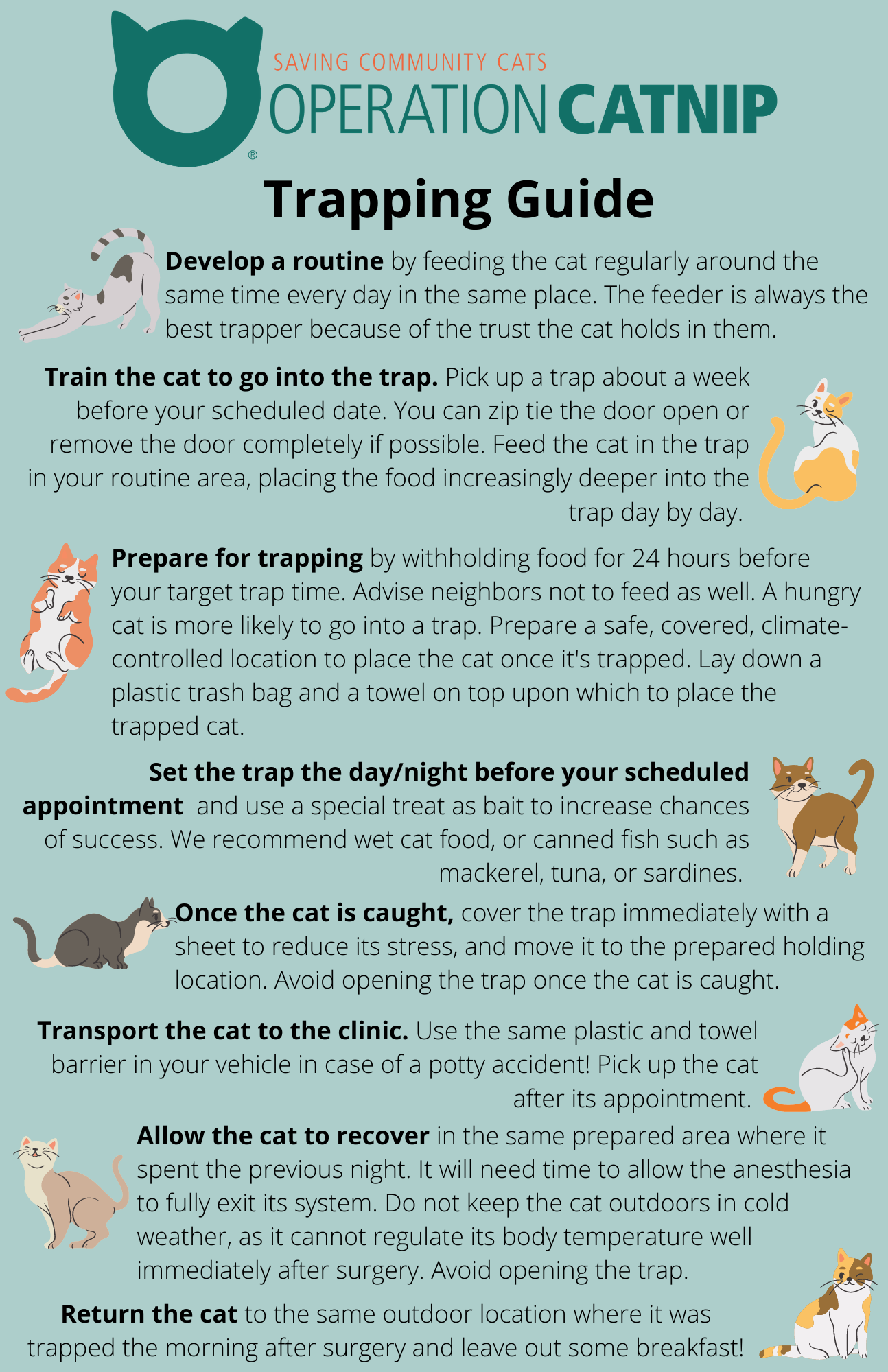TRapping tips for Hard-to-trap cats
Use a different bait- For many cats, regular canned cat food will work just fine. But for the “big guns,” we recommend extra-special, fragrant bait. Canned mackerel, canned sardines, or canned tuna are great options! Fresh and warmed fried chicken can also be very enticing.
Use a non-food bait- It’s possible to attract cats into traps without using food. Some cats can be lured in with catnip! Use a high-quality loose, dried catnip. Place a tablespoon amount into the toe of pantyhose, tying it in a knot and cutting off the excess to create a pouch. Place the pouch of catnip behind the trip plate and cover the entire trap, except for the door, with a heavy sheet. This method does not work for young kittens!
Hang the bait- Instead of placing your bait on the floor of the trap, you can tie the bait to string and hang it from the top of the trap. This works best with fried chicken.
Use kittens! (For mother cats)- If you are trying to catch a mother cat and you have access to her kittens, you can use them to lure her into a trap. Place the kittens into a carrier or a second trap if you have an extra one available. Then place the trap that you are going to set for the mother cat flush against the carrier/trap with the kittens, so that the mother cat would have to walk into the trap to get close to the door where her kittens are. Try to position the two traps so that natural barriers like bushes or trees, or buildings/structures are flush against the sides of the trap, so that she could not go around the trap to get to her kittens, she would need to go through the trap.
Obscure the trip plate- While we typically recommend that you do not place anything inside the trap except for bait, some cats are wary of the trip plate and will avoid it. You can use a sheet of newspaper to cover the bottom of the cat so that the cat does not see where the trip plate is and thus cannot avoid it.
Cover the trap- Generally, we recommend leaving the trap uncovered until the cat is trapped inside. However, for some cats, going into a covered trap is more comforting. Try covering some of the traps you have out, while leaving others uncovered, and see which method brings you better success.
Use items to disguise the trap- Try placing the trap inside a brown paper grocery bag, a large paper yard waste bag, or a cardboard box, with the front of the trap open. It’s amazing how many cats are tempted to go into the trap when they think they’re going into a bag or a box!
Double-check for additional feeders- If you find that a cat has absolutely no interest in the trap after several attempts, you may want to double check with your neighbors that no one else is feeding. Leaving a friendly note on the door or bringing over a plate of cookies along with you when you door-knock can make people very receptive to cooperating with you!
Take extra time to “train” the cat- Cats that are especially wary may just need time to get used to the presence of the trap. Remove the back door (if possible) or use a zip tie to hold the front trap door open. This way, if the cat steps on the trip plate, it will not trigger the trap to shut. The cat can comfortably walk in and out of the trap, learning through repetition that the trap is not threatening. Start by placing the cat’s food a few feet away from the front of the trap, and every day, leave the food a little closer to the trap. Over several days, continue to move the food closer and closer until the cat is willing to go in and out of the trap. Once the cat is trained, you can officially remove any zip ties or replace the back door and set your trap the night before your scheduled clinic.
Change the trap’s location or the time of trapping- Move the trap to a new area. Although you should always try and trap the cat where you see it most regularly, look around the immediate area for potential sites that may be quieter, more secluded, or more inviting to the cat. You might also try switching up the time of day that you are trapping. Perhaps you cannot rule out a “mystery feeder” who provides the cats food at night right before you’ve been setting the trap, but these same cats may be hungrier during morning times.
Borrow a larger trap- We have a few “extra large” traps in our inventory that may prove more successful for trapping a very wary cat. Reach out to us by email at info@ocgainesville.org to ensure availability.
Use a Drop Trap- Drop traps are especially handy for very trap-savvy cats. We keep several of these in our inventory and can show you how to use them! Reach out to us by email at info@ocgainesville.org to ensure availability.
Take a break- Unless the cat is in need of immediate medical attention, it’s ok to take a break to give both yourself and the cat a rest. Wait a few weeks, then try again with fresh eyes and motivation!
No matter what, don’t give up!


